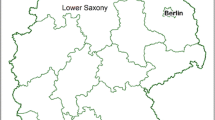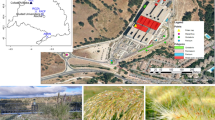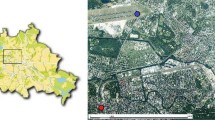Abstract
Flowering behavior of the major allergenic species Betula pendula Roth (silver birch), Dactylis glomerata L. (cocksfoot) and Alopecurus pratensis L. (meadow foxtail), was examined by phenological observations in 2009 along an altitudinal gradient (from 700 m up to 1,700 m a.s.l.) in the topographically complex Zugspitze area on the German–Austrian border. The results were compared with pollen counts derived from pollen traps located at different altitudes (720 m, 1,503 m, 2,650 m a.s.l.). Phenological onset dates showed a great dependence on altitude and on exposition. Altitudinal gradients of the two grass species showed a delay of between 6 and 7 days (100 m)−1 and can be interpreted as a temperature response rate varying between −9 and −10 days (1 °C)−1. For birch phenophases, the altitudinal gradients were ca. 3 days (100 m)−1, corresponding to temperature response rates of circa −7 days (1 °C)−1. Northern and western exposed birch trees at the same altitude showed large differences in flowering dates (5–7 days). A comparison of phenological and aerobiological data in the phenological survey area revealed good agreement in the start of season dates, especially at lower altitude. Therefore, it was local pollen emissions, not long- or medium-range pollen transport that accounted for the timing of the aerobiological start of the season. Pollen counts at the highest and vegetation-free site were particularly affected by medium-range transport. More pronounced responses to altitude and therefore to temperature for the analyzed grass species indicate a greater temperature sensitivity. This suggests that further temperature increase could result in a remarkably earlier grass pollen season and, in turn, lead to major consequences for human health. Particular wind patterns can contribute to high and medically relevant pollen concentrations even at high elevation sites, implying less favourable conditions for those people allergic to pollen.






Similar content being viewed by others
References
Badeck, F.-W., Bondeau, A., Böttcher, K., Doktor, D., Lucht, W., Schaber, J., et al. (2004). Responses of spring phenology to climate change. New Phytologist, 162, 295–309.
Barry, R. G. (1981). Mountain weather and climate. London and New York: Methuen.
Beniston, M. (2006). Mountain weather and climate: A general overview and a focus on climatic change in the Alps. Hydrobiologia, 562, 3–16.
Bortenschlager, S., & Bortenschlager, I. (2005). Altering airborne pollen concentrations due to the global warming. A comparative analysis of airborne pollen records from Innsbruck and Obergurgl (Austria) for the period 1980–2001. Grana, 44(3), 172–180.
Bruns, E. (2009). Das erste Halbjahr 2009 klimatologisch-phänologisch betrachtet. Phänologische Betrachtungen vom Deutschen Wetterdienst. Offenbach am Main: Deutscher Wetterdienst, pp. 1–2.
Cambon, G., Ritchie, J. C., & Guinet, P. (1992). Long-distance transport of airborne pollen in Southern Ontario (Canada). Canadian Journal of Botany, 70, 2284–2293.
Campbell, I. D., McDonald, K., Flannigan, M. D., & Kringayark, J. (1999). Long-distance transport of pollen into the Arctic. Nature, 399, 29–30.
Cecchi, L., Torrigiani Malaspina, T., Albertini, R., Zanca, M., Ridolo, E., Usberti, I., et al. (2007). The contribution of long-distance transport to the presence of Ambrosia pollen in central northern Italy. Aerobiologia, 23, 145–151.
Chen, X. (1994). Untersuchung zur zeitlich-räumlichen Ähnlichkeit von phänologischen und klimatologischen Parametern in Westdeutschland und zum Einfluss geoökologischer Faktoren auf die phänologische Entwicklung im Gebiet des Taunus (pp. 74–77). Offenbach am Main: Deutscher Wetterdienst.
Clot, B., Peeters, A. G., Fankhauser, A., & Frei, T. (1995). Airborne pollen in Switzerland 1994. Zürich: Schweizerische Meteorologische Anstalt.
Cornelius, C., Petermeier, H., Estrella, N., & Menzel, A. (2011). A comparison of methods to estimate seasonal phenological development from BBCH scale recording. International Journal of Biometeorology, 55, 867–877.
D’Amato, G., Cecchi, L., Bonini, S., Nunes, C., Annesi-Maesano, I., Behrendt, H., et al. (2007). Allergenic pollen and pollen allergy in Europe. Allergy, 62, 976–990.
Defila, C. (2007). Alpine Pflanzenphänologie in der Schweiz. Promet, 33, 36–39.
Defila, C., & Clot, B. (2005). Phytophenological trends in the Swiss Alps, 1951–2002. Meteorologische Zeitschrift, 14, 191–196.
DWD (Deutscher Wetterdienst). (1991). Anleitung für die phänologischen Beobachter des Deutschen Wetterdienstes. Offenbach am Main: Deutscher Wetterdienst.
Ellenberg, H. (1996). Vegetation Mitteleuropas mit den Alpen in ökologischer, dynamischer und historischer Sicht (5th ed.). Stuttgart: Ulmer.
Estrella, N., Menzel, A., Krämer, U., & Behrendt, H. (2006). Integration of flowering dates in phenology and pollen counts in aerobiology: Analysis of their spatial and temporal coherence in Germany (1992–1999). International Journal of Biometeorology, 51, 49–59.
Frei, T. (1997). Pollen distribution at high elevation in Switzerland: Evidence for medium range transport. Grana, 36, 34–38.
Galán, C., Cariñanos, P., Garcia-Mozo, H., Alcázar, P., & Domínguez-Vilches, E. (2001). Model for forecasting Olea europaea L. Airborne pollen in South-West Andalusia, Spain. International Journal of Biometeorology, 45, 59–63.
Galán, C., Emberlin, J., Dominguez, E., Bryant, R. H., & Villamandos, F. (1995). A comparative analysis of daily variations in the Gramineae pollen counts at Cordoba, Spain and London, UK. Grana, 34, 189–198.
Hirst, J. M. (1952). An automatic volumetric spore trap. Annals of Applied Biology, 39, 257–265.
Jäger, S. (2008). Exposure to grass pollen in Europe. Clinical and Experimental Allergy Reviews, 8, 2–6.
Jarvis, A., Reuter, H. I., Nelson, A., & Guevara, E. (2006). Hole-filled seamless SRTM data V3, International Centre for Tropical Agriculture (CIAT). http://srtm.csi.cgiar.org.
Jato, V., Rodriguez-Rajo, F. J., Alcazar, P., De Nuntiis, P., Galán, C., & Mandrioli, P. (2006). May the definition of pollen season influence aerobiological results? Aerobiologia, 22, 13–25.
Jochner, S., Beck, I., Behrendt, H., Traidl-Hoffmann, C., & Menzel, A. (2011a). Effects of extreme spring temperatures on urban phenology and pollen production: A case study in Munich and Ingolstadt. Climate Research, 49, 101–112.
Jochner, S., Heckmann, T., Becht, M., & Menzel, A. (2011b). The integration of plant phenology and land use data to create a GIS-assisted bioclimatic characterisation of Bavaria, Germany. Plant Ecology and Diversity, 4, 91–101.
Laaidi, M. (2001). Forecasting the start of the pollen season of Poaceae: Evaluation of some methods based on meteorological factors. International Journal of Biometeorology, 45, 1–7.
Laaidi, M., Thibaudon, M., & Besancenot, J.-P. (2003). Two statistical approaches to forecasting the start and duration of the pollen season of Ambrosia in the area of Lyon (France). International Journal of Biometeorology, 48, 65–73.
Meier, U. (2001). Entwicklungsstadien mono- und dikotyler Pflanzen. BBCH-Monographie (2nd ed.). Berlin: Blackwell Wissenschaftsverlag.
Menzel, A., & Fabian, P. (1999). Growing season extended in Europe. Nature, 397, 659.
Menzel, A., Sparks, T. H., Estrella, N., Koch, E., Aasa, A., Ahas, R., et al. (2006). European phenological response to climate change matches the warming pattern. Global Change Biology, 12, 1969–1976.
Rantio-Lehtimäki, A. (1994). Short, medium and long range transported airborne particles in viability and antigenicity analyses. Aerobiologia, 10, 175–181.
Rapiejko, P. (1995). Pollen monitoring in Poland. In R. Spiewak (Ed.), Pollen and pollinosis: Current problems. Lublin: Institute of Agricultural Medicine.
Rötzer, T., & Chmielewski, F. M. (2001). Phenological maps of Europe. Climate Research, 18, 249–257.
Rousseau, D. D., Duzer, D., Cambon, G. V., Jolly, D., Poulsen, U., Ferrier, J., et al. (2003). Long distance transport of pollen to Greenland. Geophysical Research Letters, 30. doi:10.1029/2003GL017539.
Sánchez Mesa, J. A., Smith, M., Emberlin, J., Allitt, U., Caulton, E., & Galán, C. (2003). Characteristics of grass pollen seasons in areas of southern Spain and the United Kingdom. Aerobiologia, 19, 243–250.
Scheid, G., & Bergmann, K.-Ch. (2004). 20 Jahre Stiftung Deutscher Polleninformationsdienst (1983–2003). Allergo Journal, 13, 261–268.
Scherrer, D., Schmid, S., & Körner, C. (2011). Elevational species shift in a warmer climate are observed when based on weather station data. International Journal of Biometeorology, 55, 645–654.
Smith, M., & Emberlin, J. (2005). Constructing a 7-day ahead forecast model for grass pollen at north London, United Kingdom. Clinical and Experimental Allergy, 35, 1400–1406.
Sofiev, M., Siljamo, P., Ranta, H., & Rantio-Lehtimäki, A. (2006). Towards numerical forecasting of long-range air transport of birch pollen: Theoretical considerations and a feasibility study. International Journal of Biometeorology, 50, 392–402.
Spieksma, F. T. M. (1980). Daily hay fever forecast in the Netherlands. Radio broadcasting of the expected influence of the weather on subjective complaints of hay fever sufferers. Allergy, 35, 593–603.
Van de Water, P. K., Keever, T., Main, C. E., & Levetin, E. (2003). An assessment of predictive forecasting of Juniperus ashei pollen movement in the Southern Great Plains, USA. International Journal of Biometeorology, 48, 74–82.
Vázquez, L. M., Galán, C., & Domínguez-Vilches, E. (2003). Influence of meteorological parameters on olea pollen concentrations in Córdoba (South-western Spain). International Journal of Biometeorology, 48, 83–90.
Zacharias, F. (1972). Blühphaseneintritte an Straßenbäumen (insbesondere Tilia x euchlora KOCH) und Temperaturverteilung in Westberlin, PhD thesis. Berlin: Freie Universität Berlin.
Zauli, D., Tiberio, D., Grassi, A., & Ballardini, G. (2006). Ragweed pollen travels long distance. Annals of Allergy, Asthma & Immunology, 97, 122–123.
Ziello, C., Estrella, N., Kostova, M., Koch, E., & Menzel, A. (2009). Influence of altitude on phenology of selected plant species in the Alpine region (1971–2000). Climate Research, 39, 227–234.
Acknowledgments
The research conducted in this study was supported by grant U 119 (Impacts of climate on pollen season and distribution in the Alpine region) of the Bavarian State Ministry of the Environment and Public Health (StMUG). S.J. and C.Z. gratefully acknowledge the support of the TUM Graduate School’s Faculty Graduate Center Weihenstephan at the Technische Universität München.
Author information
Authors and Affiliations
Corresponding author
Rights and permissions
About this article
Cite this article
Jochner, S., Ziello, C., Böck, A. et al. Spatio-temporal investigation of flowering dates and pollen counts in the topographically complex Zugspitze area on the German–Austrian border. Aerobiologia 28, 541–556 (2012). https://doi.org/10.1007/s10453-012-9255-1
Received:
Accepted:
Published:
Issue Date:
DOI: https://doi.org/10.1007/s10453-012-9255-1




